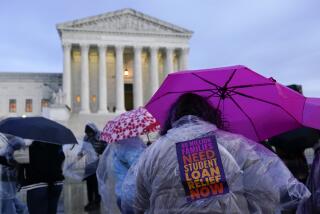Number of Poor in America Hits a 27-Year High
Economic stagnation in the first three years of the Bush Administration wiped out Americans’ income gains of the late 1980s, causing the middle class to lose ground financially and ultimately swelling the ranks of the poor to a 27-year high, according to Census Bureau figures released Thursday.
The agency said that median household income fell 3.5% in 1991 after adjustments for inflation, leaving the average family worse off in 1991 than it was when George Bush took office in January, 1989.
“What you are seeing is the American standard of living grinding to a halt,” observed Fred Bergsten, an economist at the Institute for International Economics, a Washington research firm.
“This shows that the middle-class squeeze is becoming tighter,” added Robert Greenstein, director of the Center for Budget and Policy Priorities.
At the same time, the recession pushed 2.1 million more Americans below the government’s official poverty line last year, the Census Bureau said. The number of people defined as poor rose to 35.7 million, the highest level since the start of President Lyndon B. Johnson’s War on Poverty in 1964. In 1991, poor Americans represented 14.2% of the population, up from 13.5% in 1990.
The annual income and poverty reports validated previous signs of widespread economic decline during the recessionary 1990s and quickly fed the election-year debate over President Bush’s economic and social policies.
“This is ‘are you better off than you were four years ago’ kind of stuff,” said David Wyss, an economist with DRI-McGraw Hill, a research firm based in Lexington, Mass. “And the numbers don’t look good for George Bush.”
Aides to Arkansas Gov. Bill Clinton, the Democratic presidential candidate, used the data to renew their attack on Republican economic policies of the 1980s and 1990s.
“Today’s poverty figures are yet another terrible indication of the devastation of 12 years of Republican rule,” said Clinton spokesman George Stephanopoulos. “Working Americans are becoming poorer because George Bush is doing nothing for them.”
The White House, however, sought to deflect criticism by arguing that the data simply represents an inevitable cyclical decline brought on by the slump of 1990-1991.
“Certainly I think we have to expect that the recession would have a significant and serious impact on income and on poverty levels,” said White House Press Secretary Marlin Fitzwater. “We have tried to target a number of programs in the last couple of years particularly to those problems, knowing that the recession would have a deleterious effect.”
Economists say that this year’s modest increase in economic growth should lead to some improvement in median income levels in 1992. “I think we will see a modest rise this year,” observed Alan Meltzer, an economist at Carnegie Mellon University.
But the rising unemployment rate--which hit an eight-year high in June of 7.8%--could lead to a further rise in poverty, analysts said.
“A further substantial jump in poverty is inescapable,” warned Greenstein. “I don’t remember ever seeing such a big jump in unemployment without an increase in poverty.”
It was hard to find a silver lining in the census data. While income inequality, for example, showed few signs of widening over the past year, the Census Bureau said that was largely because the steep declines in income hit the affluent as well as the poor.
“We saw a pretty broad decline in incomes during the period, but no discernible change in income inequality,” said Daniel H. Weinberg, chief of housing and household economic statistics for the Census Bureau.
After median household income reached its 1980s peak of $31,750 in 1989, it had fallen 5.1% by 1991 to $30,126--the lowest level since 1985. The drop between 1989 and 1991 was the most severe decline for any two-year period since the recessionary period of 1973-1975.
While mounting unemployment certainly was a major factor in shrinking incomes, recessionary pressures for wage concessions from workers who did not lose their jobs also clearly played a part.
Median earnings for full-time male workers in 1991 stood at $29,421, up slightly from 1990 but down sharply from the $30,129 level of 1989. Median earnings for women fell during the period as well, from $20,626 in 1989 to $20,553 last year.
The income decline also was felt across racial and ethnic lines, with whites as well as blacks and Latinos suffering losses. The sharp rise in poverty also was boosted by an increase in the poverty rate among whites as well as minorities. “Poverty increased across regions and across racial lines,” noted Greenstein.
One surprise in the poverty data, however, was the fact that Americans appear to move much more rapidly in and out of poverty and other income groups than had been assumed. The Census Bureau said that one-quarter of all people living in poverty in 1987 were no longer poor in 1988. Only one-quarter to one-third of those living in poverty can be considered long-term poor, with few prospects of moving above the poverty level, Weinberg said.
The government defines as “poor” those people whose incomes fall below the national poverty line. Last year a family of four earning $13,924 was poor, as was an individual earning $6,932 or less. In California, the poverty rate rose to 15.7% in 1991, up from 13.9% in 1990.
The bleakest statistics to emerge Thursday, however, were those showing the extent to which child poverty has expanded in America. Children accounted for 40.2% of the poor last year, while the elderly, who have benefited from the growth in Social Security, Medicare and other federal support programs, now make up just 10.6% of the poor.
“If you look at the data, you see that one out of four children below the age of 6 (is) now living below the poverty level,” noted Greenstein. “That is not good for either our future economic growth or our social stability. . . . These are the people who are going to have to grow up and compete against workers from Germany and Japan, where child poverty rates are much lower today.”
While the census data was widely used by economists and politicians to rebuke the short-term economic policies of the Bush Administration, some economists still noted that the income figures also underscored the need to address the nation’s more deeply seated economic decline--a slide many analysts believe actually began in the early 1970s.
America’s continuing failure to address its budget deficits has led to a steady drop in the nation’s rate of savings and investment, which in turn has depressed productivity and overall economic growth. Until the deficit--which now absorbs as much as 60% of national savings--is reduced, household incomes cannot rebound very much, argued Francis Bator, a Harvard economist.
“In the short run, you can say that the Bush Administration has failed to develop policies to stimulate the economy, but the basic problem is that as a nation, we are not saving and investing,” Bator said. “And until we become more productive, income growth will continue to lag.”
ELDERLY POOR: Advisory panel backs increase in benefits for supplemental Social Security program. A28
Treading Water
After adjusting for inflation, household income has crested and subsided in several distinct waves over the past 25 years. Last year’s average of $30,126, measured in constant 1991 dollars, was slightly lower than the $30,333 recorded in 1973: MEDIAN HOUSEHOLD INCOME 1991: $30,126 1990: 31,203 1989: 31,750 1988: 31,344 1987: 31,246 1986: 30,940 1985: 29,896 1984: 29,383 1983: 28,741 1982: 28,737 1981: 28,833 1980: 29,309 1979: 30,297 1978: 30,396 1977: 29,249 1976: 29,088 1975: 28,597 1974: 29,384 1973: 30,333 1972: 29,746 1971: 28,529 1970: 28,803 1969: 29,000 1968: 27,973 1967: 26,801
‘91 HOUSEHOLD INCOME BY RACE Asian/Pacific Islander: $36,449 Anglo: $31,569 Latino: $22,691 Black: $18,807
Source: U.S. Census Bureau
Poverty in America
Here are some facts and figures about Americans from the Census Bureau’s report on poverty and incomes in 1991:
* 40% of the poor were children, and nearly 11% were elderly.
* The South had the highest poverty rate at 16%. Poverty rates for other regions were the Northeast, 12.2%; Midwest, 13.2%; and West, 14.3%.
* Blacks had the highest poverty rate, 32.7%. They were followed by Latinos, 28.7%; Asians and Pacific Islanders, 13.8%; and whites, 10.7 %.
* 40% of poor people age 15 and older worked, and 9% had year-round, full-time jobs.
* 29% of the poor lacked medical insurance.
* 14% of all Americans lacked health insurance coverage.
Source: Census Bureau
More to Read
Get the L.A. Times Politics newsletter
Deeply reported insights into legislation, politics and policy from Sacramento, Washington and beyond. In your inbox three times per week.
You may occasionally receive promotional content from the Los Angeles Times.






